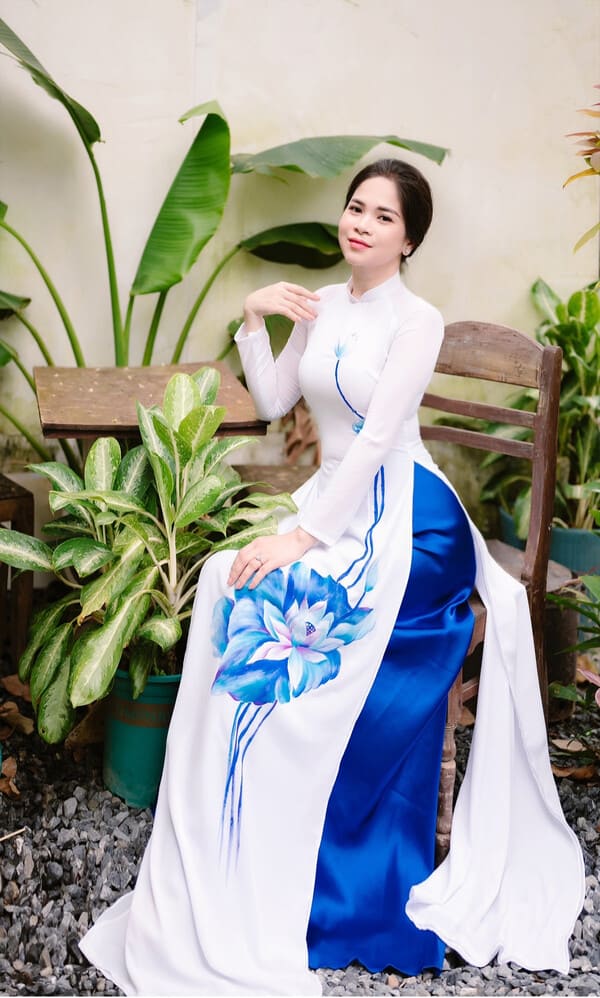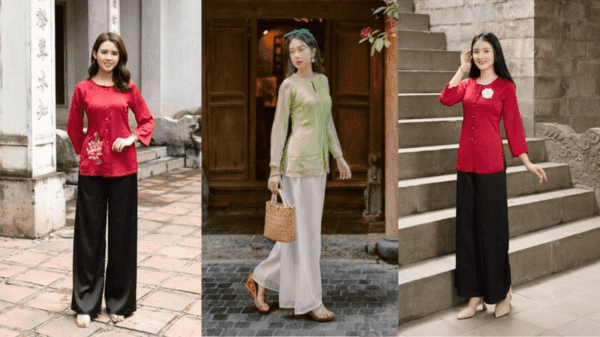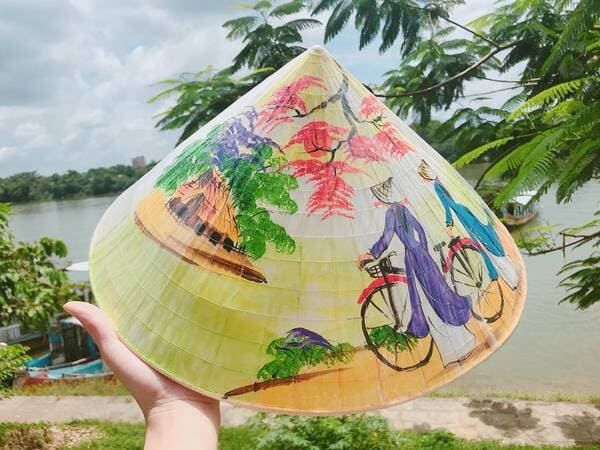Handbook
5 National Costume Vietnamese [can not be ignored]
Vietnamese national costumes are very diverse and rich, with materials, styles and costume patterns that are unmatched anywhere else. Now, let’s learn about Vietnamese media costume models with Balala – (bamboo water) right in the article below.
1. Ao Dai
As a westernized costume model, the Vietnamese ao dai has a tight upper body that accentuates the beauty of the woman, and the bottom is divided into 2 long pieces of fabric to create a graceful, soft look.
The sleeves are measured from the shoulder, sewn close to the arm, with short sleeves or long sleeves that reach past the wrist. The ao dai is worn with pants instead of the skirt of the past. Long clothes are sewn to the heel, with wide trouser legs. Ao dai was once sewn with sturdy fabric, but now it is often sewn with soft, flowing fabric. The most common color is white. But the current fashion trend is for long clothes to match the color of the shirt. But today it is also innovated with a long skirt to create a gentle, elegant look.

Ao Dai is sewn from many types of fabrics such as synthetic silk, silk, velvet, brocade, but the common characteristic is that it must be thin and light to create the beauty of the ao dai. Middle-aged women like to wear brocade and velvet ao dai for solemnity and wear it on important occasions such as weddings and holidays. Young women like to wear ao dai with light materials and youthful, bright colors. Accompanying the ao dai are satin pants or white, black, or silk pants of the same color as the ao dai.
Nowadays, ao dai is also transformed by designers with many different methods. There are ao dai printed with landscape paintings, with additional patterns and motifs that look extremely attractive and impressive.
2. Four-piece shirt – “áo tứ thân”
The ao dai falls from the neck to about 20 cm below the knee. The shirt has two flaps, front and back. The front flap has two separate flaps along the length. The back flap is also divided into two, but sewn together to form a long line called the shirt spine. Because at this time, the width of the fabric was only about 35–40 cm, so the hems had to be sewn together to form a flap.

The four-piece ao dai consists of two flaps and four flaps. The four-piece shirt has no buttons, is long and has two sleeves to put on when wearing. Inside, the girl wears a camisole. It can be a built-in collar or a swallow-wing cover cut deep all the way to the bottom. The bib has a heavy color for middle-aged ladies or a deep peach color for young girls. This color gives the bib the name “enchantment for monks” bib. Over the bib is a thin, pure white blouse. The girl braided a green belt to keep the combination of the short blouse and skirt waistband light. This green belt also has a decorative value in terms of color. The outermost part is a four-piece shirt that hangs down gracefully, making the girl’s body neat and slim. The four-piece shirt has no buttons when worn, and when worn, the hands are inserted into the sleeves. That’s enough clothes to be able to work, show off, and go here and there.
The back of the shirt consists of two pieces of fabric joined together, usually brown or light brown combined with the same color; In the front, there are two separate bodies, tied together, hanging in front of the belly to create a slim figure. The top is not tightly tied but reveals the colored camisole inside; collar hemmed 1 – 2 cm. The four-piece shirt is almost heel-length, and the sleeves are tight.
3. Ba Ba shirt – “áo bà ba”
To introduce Ba Ba Ao Dai, this is the traditional costume of the people of Southern Vietnam. The top part that covers the body is called the mantle. It is mostly associated with the countryside of Southern Vietnam, especially in the Mekong Delta.

Regarding the question of the English name of Ba Ba shirt, currently this type of outfit does not have an official English name. However, there is a phrase that quite closely describes the Ba Ba shirt, which is: loose-fitting blouse.
Ba Ba shirt is a shirt without a collar, the back body is made of one piece of fabric with the front body consisting of two pieces and in the middle there are two strips of buttons running from top to bottom. The shirt is tight at the waist, with moderate slits on both sides. The shirt has a length that covers the buttocks, almost tight to the body, highlighting the woman’s beautiful body curves.
The origin of Ao Ba Ba is from Malaysia or Singapore. The Ba Ba Ao Dai was introduced to Vietnam in the late 19th century, and is the costume of the Ba Ba people – a Chinese ethnic group mixed with Malays in Malaysia or Singapore. Black fabric is imported quite well. Southern people like to wear the black fabric shirt of the Ba-ba people, so it is called Ba Ba shirt. Nowadays, Ba Ba Ao Dai has had many improvements to better suit the modern pace of life but still retains the traditional features of the old Ba Ba Ao Dai.
When Vietnamese people mention the image of Ba Ba ao dai, they often immediately remember grandmothers, mothers, and sisters in the South, who are people who are both simple, rustic, and approachable. Every time you go to the Southern region, you can see images of people rowing boats and doing river activities.
The Ba Ba Ao dai also symbolizes the image of Vietnamese women who are resilient and strong in the wars against the enemy and to defend the country. The image of Southern women is always associated with three inseparable objects such as: Ba Ba shirt, bandana, and conical hat. The images of mothers and sisters rushing into battle are still sparklingly beautiful to this day.
4. Non La hat
The conical hat is often woven from different types of leaves such as: palm leaves, loose leaves, straw, bamboo, mortar leaves, lake leaves, pandan leaves, coconut leaves, etc. The hat often has colorful straps made of soft fabric like velvet or silk to hold on the neck.

Hats are usually pointed, but there are also some types of hats that are wide and have a flat top. The conical leaves are arranged on a frame consisting of small bamboo slats bent into an arc shape, pinned together with threads, or silk and monofilament fibers. The spokes of the cone are made from thin, small and flexible bamboo sticks and then bent into circles of different diameters to form cone brims. All are arranged next to each other on a pyramid-shaped mold.
To make a conical hat, the craftsman takes each leaf, flattens it, then uses scissors to cut the top diagonally, then uses a needle to thread about 24 to 35 leaves together at once, then arrange them evenly on the hat mold. . The cone leaves are thin and easily damaged when exposed to a lot of rain, so the craftsmen used dry bamboo sheaths to make the layer between the two layers of cone leaves, making the cones both hard and durable.
5. Traditional costumes of Vietnamese ethnic groups

- Tày costumes, particularly in Northern Vietnam, exude a sense of subdued elegance. Women wear indigo jackets and skirts embellished with silver buttons and sashes, while men sport loose pants and head turbans. The simplicity of their attire carries a timeless beauty and reflects the Tày people’s connection to nature and their surroundings.
- Influenced by their Islamic heritage, Cham costumes showcase intricate embroidery and vibrant colors. Women wear brightly colored sarongs and headscarves, while men don loose pants and tunics adorned with geometric patterns and gold accents. The Cham people’s unique sense of artistry shines through in their elaborate costumes.
- Thai costumes are characterized by their use of natural materials and intricate batik techniques. Women wear long skirts and blouses dyed with indigo and adorned with floral patterns, while men sport loose pants and jackets woven from hemp and bamboo. The Thai people’s connection to the natural world is evident in their earthy and elegant costumes.
- Hmong: Known for their stunning and meticulously embroidered garments, Hmong costumes are often layered with skirts, jackets, and headpieces adorned with geometric patterns, floral motifs, and intricate needlework. Men typically wear indigo jackets and pants, while women sport a kaleidoscope of colors and textures.
- Dao costumes are known for their bold colors and contrasting patterns. Women typically wear indigo jackets and skirts adorned with red and white trim, while men sport head scarves and jackets decorated with geometric motifs. The Dao people’s vibrant attire reflects their joyful and energetic spirit.
Visit Vietnam and immerse yourself in the world of ethnic costumes by attending cultural festivals or visiting villages where traditional costumes are still worn every day. And that’s all the information about Vietnamese national costumes, hopefully providing a lot of useful information for you.




Tin Tức mới nhất
[5 minutes] Learn about all the handicrafts in Vietnam
Handicrafts in Vietnam are famous for their beauty, quality and tradition. It’s a great way...
5 useful information about Vietnam water puppets
Vietnamese water puppetry is a fascinating art form with a rich history and unique appeal....
16 traditional festival in vietnam [Overview]
Do you know traditional festival in Vietnam? If you don’t know or lack information, please...
5 National Costume Vietnamese [can not be ignored]
Vietnamese national costumes are very diverse and rich, with materials, styles and costume patterns that...
Traditional culture in Vietnamese [10 minutes to know it all]
Traditional culture in Vietnamese is a diverse picture , rich history, and a deep connection...
Customs and traditions of Vietnam [6 important notes]
What are the special customs and traditions of Vietnam? This is a country with more...